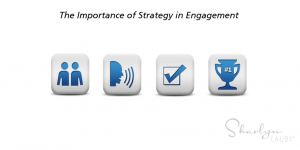Sharlyn J. Lauby's Blog, page 168
October 29, 2015
Use Storytelling to Create Employee Engagement
One of the key ingredients to organizational culture is its stories. At this year’s WorkHuman conference hosted by Globoforce, one of the sessions focused on effective storytelling. The speaker mentioned four principles from Steve Denning that are essential to effective storytelling:
Be true.
Be positive.
Be succinct.
Show growth.
As I was thinking of these principles, it reminded me of the opportunities we have to engage employees with our storytelling. It could be said that the principles of engagement are based upon truth, positivity, effectiveness, efficiency, and a desire to move forward. So the two are very much aligned. There are five types of storytelling you can use to connect candidates and employees with your organization:
Stories about the history of the company. Years ago, I worked for an airline and one of the first stories employees heard was about the founder. He was the guy “who sold you the ticket, put your bags on the plane and then flew the plane.” We told the story during recruiting fairs, in orientation, etc. This storytelling not only gave you a history lesson but it told you something about the company’s founding principles.
Stories explaining how decisions are made. At some point, the same airline was looking to save some serious expenses. So instead of just cutting the budget, they went to employees and explained the situation. They created a suggestion contest that financially rewarded employees for developing ideas that either increased revenue or reduced expenses. The result positively impacted the organization in the millions.
Stories about employees delivering exceptional service. Mr. Bartender and I were recently in Tampa. When we checked-in, there was a sign at the front desk talking about mosquitos in the area and recommended to take precautions. In fact, the hotel said they would provide bug spray to guests upon request. Since we didn’t have bug spray with us, I asked about it. The front desk clerk looked around and couldn’t find any bug spray behind the front desk. Instead of telling us he couldn’t find any or the hotel was out of it, he walked over to the gift shop, grabbed a package of bug spray, told the cashier to charge it to the hotel and handed it to me. I will tell that story for years. I hope the hotel does too.
Stories about how employees interact with each other. Most of the organizations I’ve worked for have used some form of collaborative hiring, where teams were formed to strategize and recruit. One of the things I’ve learned is that candidates immediately sense if the recruiting team is truly a team. They can tell by the way the team members interact and by the stories they share about the organization.
Stories about what the world will be like in the future. I grew up in Orlando, Florida during the time that Walt Disney World was being built. There used to be a television show called “The Wonderful World of Disney” where Walt Disney himself would do the storytelling, sharing with viewers a sneak peek into the construction of Walt Disney World. I remember watching him explain EPCOT for the first time. Organizations have a powerful way to share their stories today directly with consumers using mobile, social and video.
Our organizational stories tell candidates, employees and customers who we are. They allow people to see what the company is really all about. They create a sense of company “community.” And they create engagement.
Oh and P.S. A great friend to HR Bartender, Jonathan Segal from the firm Duane Morris, and I are partnering with SHRM for a NextChat on corporate communities. Mark your calendar for November 4 at 3p Eastern. Never been on a Twitter chat? No worries. You can learn more here. It’s a lot of fun.
Image courtesy of Sharlyn Lauby
The post Use Storytelling to Create Employee Engagement appeared first on hr bartender.






October 27, 2015
Missing Evaluations: How to Handle – Ask #HR Bartender
Now THIS is a really good question. While it is a unique situation, it’s one that happens.
Hello! Just looking for advice on how to handle the following situation: We’ve had a lot of management turnover in the last year and there are several employees who did not receive their 2014 annual review. Their former supervisors are no longer with the company and the new supervisors are needing to complete 2015 annual evaluations. What is the best way to handle missing evaluations (2014) if their current supervisor did not even work for the company at that time?
Whether you love or hate performance reviews, employees expect them. In many organizations, they drive merit increases and promotions. So missing evaluations can have consequences. Here are three things to consider:
Cover your legal bases. I do not know the state, country, industry, etc. in the situation. Spend a couple dollars and call your friendly labor attorney to make sure you are in compliance. It’s possible you might need to document the situation for the employee’s personnel file so everyone can remember what happened. Make the call and find out directly from them.
Talk with managers. Remind them of the purpose for performance reviews. Providing employees with feedback is important. Also, use this as a moment to discuss the performance review process. Are there steps that can be put into place so this situation doesn’t happen again? I do not know if this organization uses focal or anniversary reviews, it might be worth having a conversation about the pros and cons. It’s also possible that using performance management software can help to alleviate this situation.
Talk with the employees. Let them know that not doing their review was certainly not the company’s intention. Make sure the employee knows the current review process. And confirm for them that they will get a review this year. This is also a good time to remind employees about performance expectations, etc. Use the conversation as a way to reset the performance review process.
The important thing here is don’t sweep missing evaluations under the rug. It’s a mistake and it needs to be addressed. But the organization has an opportunity to recover and even make the performance management process stronger for the future.
Image courtesy of Sharlyn Lauby
The post Missing Evaluations: How to Handle – Ask #HR Bartender appeared first on hr bartender.






October 25, 2015
Self-Management Success: Manage Personality Conflicts (Part 4)
In part three of this series, we talked about the need to be problem solvers. But what happens if the “problem” is another person? Well, that’s the fourth competency of self-management: being able to handle personality conflicts.
In reality, we’re not going to get along with everyone. But we still need to be able to work with others and get our jobs done.
When we work in a traditional office environment, there’s always another person around who can help us resolve conflicts. Whether it’s our supervisor or human resources, they can facilitate a conversation and hopefully assist in reaching a resolution. In a virtual or autonomous environment, we have to resolve these conflicts on our own.
One way to examine personal conflict situations is to take the “person” part out of the equation and look at the circumstances creating the conflict. When taking the person out of the equation, it’s still necessary to make sure the other person knows that having a good working relationship is important. Ask for their help in trying to reach a solution everyone can live with. Then examine the circumstances creating the conflict. In my experience, I’ve found the conflict often includes one of these three scenarios:
Conflict #1 – We don’t agree with the data.
In situations where the conflict is created because people can’t agree with the data, research and information, the best way to solve it is with more research. For example, Jane and John have a conflict. John believes the data from XYZ is correct and Jane believes the information from ABC is more accurate. This can create personal conflict in the forms of distrust in each other or thinking the other person isn’t doing enough work. By engaging in more research, they can hopefully find a common research source they can both rely upon.
Conflict #2 – We don’t agree on the goal.
When the conflict surrounds goals and objectives, the way to resolve the conflict is with negotiation and compromise. Using our example above, John and Jane can’t agree on the desired outcome for the project. Both of them are frustrated and start to believe there are office politics or hidden agendas involved. By working together on a compromise, they are both able to have a say in the final goals of the project. Think win-win instead of a zero-sum game. If you’re thinking “politics” right now, you’ve pretty much got it.
Conflict #3 – We don’t agree on the action.
Lastly, if the conflict is regarding the work that needs to be done then consensus is the means to conflict resolution. John wants to do ABC and Jane would prefer to do XYZ. John and Jane should use their research (from number one) and compromise (from number two) to create an outcome they can both live with. Notice I didn’t say they both needed to love it. That’s not the purpose of consensus. Consensus is about finding a solution all parties can live with.
As you can see, a key component to resolving conflict is understanding ourselves. When we can use the information we know about ourselves to step outside of conflict, we can begin a dialogue and work toward resolving the matter.
Speaking of knowing ourselves, our next self-management skill deals with something we don’t spend nearly enough time talking about…and that’s understanding how we like to learn.
Image courtesy of Sharlyn Lauby
The post Self-Management Success: Manage Personality Conflicts (Part 4) appeared first on hr bartender.






October 23, 2015
Build It For the Long Haul – Friday Distraction
There’s a phrase “for the long haul” meaning long-term or over the course of a long time. The idea is that the “thing” you’re working on should last a long time.
Creating something that lasts doesn’t mean it can’t be changed or improved. I think about my first iPhone. It’s changed and gotten better over time. Some of those changes are software and some hardware. But it seems evident that the iPhone wasn’t created to be a short term fad or trend. It’s changed the way we live and do business.
Today’s Time Well Spent from our friends at Kronos plays off the famous adage “Rome wasn’t built in a day.” It means all good things take time. Especially things you want to last for the long haul.
BTW – In working on this post, I ran across another quote about Rome. “Rome wasn’t built in a day, but it burned in one.” I don’t recall ever hearing that one before. But in today’s fast paced social media world, it rings true. As business professionals, we have to make sure our organizations provide value. As tempting as it might be to hold a product or service until it’s perfected, it’s possible the rest of the world will declare the need for it irrelevant.
Definitely a balancing act between the need to stay in the game and the need to provide maximum value.
The post Build It For the Long Haul – Friday Distraction appeared first on hr bartender.






October 22, 2015
Company Promised a Second Interview – Ask #HR Bartender
This reader question happens more often than it should.
I have a query. I interviewed recently with an investment bank. The interviewer gave me some positive feedback and said he was happy with our conversation. He emailed me later that “I will get another call (from HR) for a second interview with his manager.” I’m trying to call HR – she’s not responding to my calls or emails. I asked my interviewer and he said to let him follow it up with HR.
Now I’m waiting! How do you see this situation? Should I expect a call for a second interview? Thanks in advance. I appreciate your response on this.
One of the biggest complaints I hear from candidates is not knowing the status of their application. Every interview should end with a conversation about next steps – when to follow-up, how to follow up, and who to follow up with. Whether you’re the recruiter, hiring manager or candidate, if it doesn’t come up…bring it up.
Okay, now that I’m off my soapbox about following up, let me offer some things to think about when it comes to this situation about a second interview.
Timing – In this situation, we don’t know when the email was sent, when the candidate tried to call HR, and how long the candidate has been waiting. I know it’s frustrating for the candidate. They are excited and want to get hired. And the company wants to hire someone too. Please remember that the company isn’t trying to deliberately avoid you or any other candidate. Sometimes the daily business gets in the way. It’s not always an acceptable excuse, but it does happen.
Responding – The candidate has called, emailed and followed up with the interviewer about the promised second interview. The ball is in the company’s court (so to speak). More calls and emails will not make the company move any faster. Remember, the way you follow-up during the hiring process is an indicator of what the company can expect working with you. There’s a fine line between persistence and pest. Consider the impression you’re sending.
Reputation – I know it’s easier said than done but candidates need to start asking themselves if they want to work for companies that don’t answer their calls and emails. If a company doesn’t answer during the interview process, do you honestly believe they will answer when you’re an employee? Candidates need to remember they are interviewing the company as much as the company is interviewing them.
Candidates today have a lot of options. This is a good thing because your goal as a candidate is to get multiple job offers. Many organizations are putting focused energy and resources toward delivering an award-winning candidate experience. Part of that means following up when they said they would. That being said, candidates need to respond appropriately as well.
Image courtesy of Sharlyn Lauby
The post Company Promised a Second Interview – Ask #HR Bartender appeared first on hr bartender.






October 20, 2015
Knowing the Strategy is Different From Connecting With It
There’s a big difference between knowing what the strategy is and being able to connect with it. Bottom-line: the difference is engagement.
Organizations create strategies all the time. They communicate those strategies on a regular basis. For example, you could read a company’s strategy in the news. That doesn’t mean you’re connected with the strategy. It simply means you’ve read it, comprehended it, or agreed (or perhaps disagreed) with it. Maybe you can even articulate it.
Connecting to or engaging with a strategy is different. The first part is the same. In order to connect with a strategy, you have to know it and understand it. During this year’s SilkRoad Connections conference, I heard the phrase, “communicate 70 times in 70 different ways.” I don’t know that you have to take the “70” number literally but I think it’s a great point. We each have our preferred methods of communication. If you want me to know something, then you have to present it to me in my preferred communication method and style – that might be email, or social media or in person.
But after you communicate the strategy, then what? How can you create connection? Well, here are a few things to consider:
Develop goal or values icons to show the connection. Sometimes we need to take the extra step of showing the connection between goals, strategies and organizational values. One organization at the conference included goal icons and values icons (see image above) in their communications so employees could see how the pieces fit together.
Create an online magazine. No need to print an expensive publication – I immediately thought of apps like Flipboard with this suggestion. Think about opportunities to curate information about the organization for employees to read on their mobile devices. Another way for employees to get the information they want in a format that’s easy to digest.
Establish a beta group. I’ve been involved in a few of these lately for apps that I use and it’s fun. Ask for a few volunteers to get feedback about communication effectiveness. You can create a secret Facebook group to manage activity – that way you can get perspectives from all over the organization, not just the employees near you. And you create connection – with the employees in the beta group as well as in the effectiveness of subsequent messages.
Hire an HR Communications Manager. I’ve been hearing about an increasing number of companies hiring internal communications managers. Their role? To make sure employees don’t say, “But I didn’t know…” I’m a little torn about this suggestion. On one hand, it’s great because you can never have too much communication. On another, hiring a communications specialist cannot absolve the rest of the organization from communicating.
The goal in creating organizational strategy is to have employees engage with the strategy. Otherwise, it’s just words on a page. Engaging with the strategy makes it happen. It brings the strategy to life. The way to do that is via communication and connection.
Image courtesy of Sharlyn Lauby
The post Knowing the Strategy is Different From Connecting With It appeared first on hr bartender.






October 18, 2015
What’s Your Recruiting Competitive Advantage
I’ve mentioned a few times recently that the hiring market has shifted to the candidate. And we’re seeing some of the effects with increased time to fill metrics. I ran across this article recently that talks about how more than half of organizations don’t have enough internal candidates to fill their succession plan. Maybe the situation is more than just “mention” worthy.
I was on a webinar recently with our friends from HireRight and we asked participants if they had noticed a change in hiring. 70 percent said it has definitely become more challenging to find qualified candidates. 21 percent followed, saying they’ve seen a small change. That’s 91 percent. (9 percent indicated either no change or they’re not hiring.)
Now, I do realize this wasn’t a scientific poll. But it reminded me of a session I attended during this year’s Great Place to Work conference. To give you some perspective, the conference organizers shared with me that there were approximately 1200 attendees at the event representing almost 400 companies. Since there are only 100 companies on the Fortune Best Companies to Work For list that tells me organizations attend the event not only to show their support and share their story, but to find out how to become a better employer.
So I was in a session about how the Fortune list is developed and how to apply. An impromptu survey in the room showed over 50 percent of attendees were applying as a way to attract and retain talent.
It’s no longer about the shift to a candidate driven market. On some level, that’s a given. It’s about how organizations are going to create a recruiting competitive advantage. There are many ways to do it.
Businesses need to have a conversation about what their recruiting competitive advantage is going to be. Your competitive advantage is what makes you better than everyone else. In this case, it’s what makes your organization a better employer than everyone else.
If organizations want to hire the best talent and they want to keep their talent pipeline filled, they need to clearly understand their recruiting competitive advantage. And make sure everyone in the organization knows it as well.
P.S. If you want to hear more about becoming an award-winning place to work, check out this Workforce Institute podcast. With me on the conversation is Joyce Maroney, director of The Workforce Institute at Kronos and best-selling author Dan Schwabel, founder of WorkplaceTrends.com. We talk about having a transparent cultural identity, the qualities of best employers, and some ways companies can improve their workplace on a limited budget. Lots of great information for you!
The post What’s Your Recruiting Competitive Advantage appeared first on hr bartender.






October 16, 2015
Job Seekers Numbers At a 4 Year High – Friday Distraction
Not only has recruiting shifted to a candidate-driven market, but the number of people open to changing jobs has spiked. This is good news for job seekers looking for a great opportunity and recruiters looking for the best talent.
For organizations, it means that establishing a solid recruiting strategy is essential. A haphazard approach will not get you the results you’re seeking. Today’s infographic, courtesy of LinkedIn, shares information to help you develop a recruiting strategy to attract those job seekers at every stage of their journey. It confirms things we should already know – like the number one channel for discovering a new opportunity is via referrals. But it also shares some data that organizations need to notice. I thought the information about speed in the hiring process was very interesting.
As we start to think about 2016 strategies, organizations would be well served to review their employment brand and discuss how they will remain competitive when it comes to attracting and retaining talent. This is one of those times when being proactive will reap big rewards.
The post Job Seekers Numbers At a 4 Year High – Friday Distraction appeared first on hr bartender.






October 15, 2015
Self-Management Success: Be Part Of the Solution (Part 3)
One of the nice things about working in an office environment is the camaraderie. Especially if we run into a problem. We can leave our cubicle and find someone to talk to or help us figure it out. Even in a telework situation, we can pick up the phone and chat with a co-worker. In a self-managing environment, that dynamic changes, and we have to work through our problems.
The first step in solving our problems is understanding whether the situation we’re faced with is really a problem. In the book “Polarity Management: Identifying and Managing Unsolvable Problems,” author Dr. Barry Johnson talks about the differences between problems and polarities. His theory is that sometimes we try to use a problem-solving approach on something that’s really not a problem at all.
My definition of a problem is “the difference between what you have and what you want.” Examples of problems include: “How do I get to I-95?” or “Should we merge with XYZ Company?” In these instances, once you get to I-95 or merge (or not) with XYZ Company, the problem is solved.
By contrast, a polarity occurs when you have two opposing forces. For example, centralization versus decentralization is a polarity. This is a polarity because neither centralization or decentralization are wrong – they are just two different approaches. And even when you choose one, you still have ongoing dynamics to deal with (translation: it’s not over.) Dr. Johnson elaborates in his book how polarities are not problems and the specifics of how to manage the opposing forces of a polarity. It’s a fascinating read.
But for now, let’s focus on problems. You’ve analyzed the situation and you know you have a problem. What’s next? Well, here’s a three-step approach to working through the problem. This is known as the STP model of problem-solving.
STP is an acronym for Situation – Target – Proposal. Think about a problem that you’re currently experiencing. You can ask yourself the following questions to work through the problem:
Step One: Assess the Situation
During the Situation phase, you have the opportunity to examine the circumstances. Ask yourself the “who, what, where, when, why” questions to fully understand the matter. Also, don’t forget to ask questions about the extent of the problem, any patterns that might exist, and what the cause is. You’re able to collect any relevant information, understand the dynamics of the problem, and the possibilities in terms of changing the situation. Using the example above, you’re driving along and realize you need to be on I-95. Congratulations, you know the situation.
Step Two: Identify the Target
The next phase, allows you to identify the Target, or the end to the problem (i.e. arriving at I-95). This is ultimately what you want to accomplish or your vision of what would happen if the problem were solved. Identifying the Target will also help to clarify the issues involved in solving the matter. You can also see if there is anything you would like to avoid – like getting lost on the way to I-95 or maybe not hitting any toll roads.
Step Three: Generate Proposals
Now that you’ve accurately assessed the problem and determined the Target, use the Proposal step as a way to prepare the action plan to solve the situation. This is when you generate ideas and develop a plan to solve the problem. Examples would be using your GPS, downloading a Google map on your phone or stopping for directions.
The STP model is a systematic method that can guide you through any problem.
In the first two posts of this series, we talked about knowing ourselves and doing meaningful work. Being able to solve problems adds another layer to our self-management competencies. When we’re able to understand our strengths and weaknesses and apply those in the context of work, it helps us correctly assess, develop and implement a solution to the problems we face.
But what happens when that problem is another person? Well, that’s our next self-management quality – conflict management.
Image courtesy of Sharlyn Lauby
The post Self-Management Success: Be Part Of the Solution (Part 3) appeared first on hr bartender.






October 13, 2015
Performance Management: How to Stand Out In a Crowd
I believe that every employee wants to do their best work. And the goal of organizations should be to position employees where they can accomplish this. The question becomes . . .what’s the best approach?
According to Marcus Buckingham, it’s to focus on your strengths.
I know, that sounds incredibly simple. But, finding your strengths can be a thought-provoking journey. That’s why TMBC has released a new book, Standout 2.0 and a tool to help individuals find their strengths. The company is being recognized during this year’s HR Technology Conference and Exposition as one of the Awesome New Startups for HR, and Marcus will be delivering a keynote session. I asked if he would give us a sneak peek into his session and he very graciously said yes.
Marcus, I was introduced to your work with First, Break All the Rules and Now, Discover Your Strengths , which focuses on the idea that its strengths (not weaknesses) that are the key to outstanding performance. Can you give us a little background on how you came to this discovery?
[Marcus] After spending 20 years at Gallup researching employee engagement and interviewing thousands of workers in countries around the world, I began to see a trend with top performing managers or ‘team leaders’ as we prefer to call them. The best team leaders focused on their employees’ strengths and talents, instead of their weaknesses.
They also found ways to measure, count and reward positive outcomes. It’s not rocket science, yet it’s revolutionary because most performance management tools focus on improving weaknesses. Ultimately, people will produce the best results by making the most of their unique personal strengths rather than focusing on their weaknesses or perceived deficiencies.
I totally agree that often, in the business world, the focus is on fixing what’s wrong versus leveraging what’s right. As a leader, how do we get people to shift their mindset toward strengths?
[Marcus] Show them the data. We recently introduced the world’s first standardized Global Engagement Index and the numbers don’t lie. Although China and the U.S. ranked highest in engaged employees, just 19 percent of workers in both countries feel fully engaged.
The Index also reveals that in all 13 countries surveyed, despite significant cultural differences, the single biggest driver of fully engaged employees is the statement: “I have the chance to use my strengths every day at work.” Although corporate methods, behaviors, and values vary by country—and by industry—the most powerful human need at work remains the same: help me discover my strengths and help me use them a lot.
When companies really get this and have the tools to measure, count and reward positive outcomes, we believe they will become less obsessed about fixing employee weaknesses — and especially when they begin to experience the positive business outcomes of shifting the focus to strengths.
Discover your greatest strengths and use them as much as you can every day.
Click To Tweet
Your new book, StandOut 2.0 , concentrates on team development. Why is finding our strengths so important in a team environment?
 [Marcus] Once an employee discovers their greatest strengths and uses their strengths as much as they can, the team begins to benefit and when the entire team knows what strengths every team member has, roles can be maximized for a higher performing team. High performing companies are essentially made up of very high performing teams.
[Marcus] Once an employee discovers their greatest strengths and uses their strengths as much as they can, the team begins to benefit and when the entire team knows what strengths every team member has, roles can be maximized for a higher performing team. High performing companies are essentially made up of very high performing teams.
StandOut 2.0 includes a tool to identify strengths. Tell us what we can expect to learn and how we can apply that information in our professional lives.
[Marcus] The new StandOut strengths assessment measures nine strength roles and reveals your top two. These two strength roles are where you will make your greatest contribution and where you will have a natural advantage over everyone else. In addition to the assessment, a robust twenty-page report full of actions customized to your results is also provided so you can find your edge and really excel at work.
My thanks to Marcus for sharing his knowledge with us. As organizations continue to become less hierarchical and more autonomous, it will be essential for employees to understand their strengths. It will help them stand out individually, and it will enhance their contributions to the team and the organization. I look forward to learning more during the HR Tech Conference.
Image courtesy of Sharlyn Lauby
The post Performance Management: How to Stand Out In a Crowd appeared first on hr bartender.






Sharlyn J. Lauby's Blog
- Sharlyn J. Lauby's profile
- 10 followers














